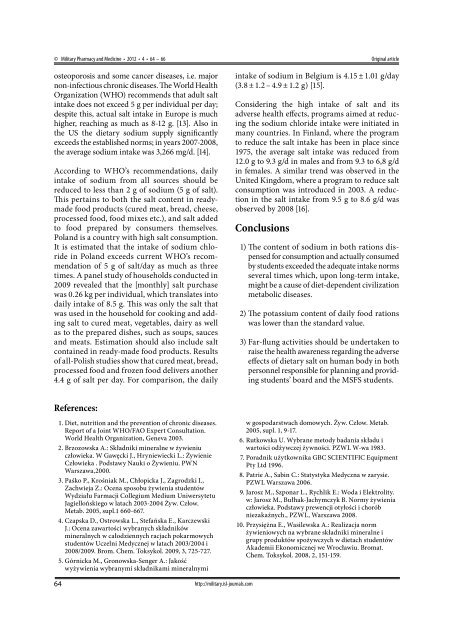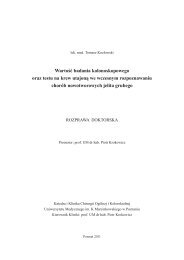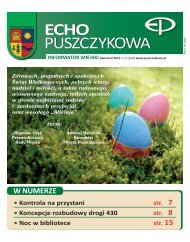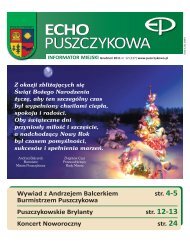MILITARY PHARMACY AND MEDICINE
MILITARY PHARMACY AND MEDICINE
MILITARY PHARMACY AND MEDICINE
Create successful ePaper yourself
Turn your PDF publications into a flip-book with our unique Google optimized e-Paper software.
© Military Pharmacy and Medicine • 2012 • 4 • 64 – 66osteoporosis and some cancer diseases, i.e. majornon-infectious chronic diseases. The World HealthOrganization (WHO) recommends that adult saltintake does not exceed 5 g per individual per day;despite this, actual salt intake in Europe is muchhigher, reaching as much as 8-12 g. [13]. Also inthe US the dietary sodium supply significantlyexceeds the established norms; in years 2007-2008,the average sodium intake was 3,266 mg/d. [14].According to WHO’s recommendations, dailyintake of sodium from all sources should bereduced to less than 2 g of sodium (5 g of salt).This pertains to both the salt content in readymadefood products (cured meat, bread, cheese,processed food, food mixes etc.), and salt addedto food prepared by consumers themselves.Poland is a country with high salt consumption.It is estimated that the intake of sodium chloridein Poland exceeds current WHO’s recommendationof 5 g of salt/day as much as threetimes. A panel study of households conducted in2009 revealed that the [monthly] salt purchasewas 0.26 kg per individual, which translates intodaily intake of 8.5 g. This was only the salt thatwas used in the household for cooking and addingsalt to cured meat, vegetables, dairy as wellas to the prepared dishes, such as soups, saucesand meats. Estimation should also include saltcontained in ready-made food products. Resultsof all-Polish studies show that cured meat, bread,processed food and frozen food delivers another4.4 g of salt per day. For comparison, the dailyOriginal articleintake of sodium in Belgium is 4.15 ± 1.01 g/day(3.8 ± 1.2 – 4.9 ± 1.2 g) [15].Considering the high intake of salt and itsadverse health effects, programs aimed at reducingthe sodium chloride intake were initiated inmany countries. In Finland, where the programto reduce the salt intake has been in place since1975, the average salt intake was reduced from12.0 g to 9.3 g/d in males and from 9.3 to 6,8 g/din females. A similar trend was observed in theUnited Kingdom, where a program to reduce saltconsumption was introduced in 2003. A reductionin the salt intake from 9.5 g to 8.6 g/d wasobserved by 2008 [16].Conclusions1) The content of sodium in both rations dispensedfor consumption and actually consumedby students exceeded the adequate intake normsseveral times which, upon long-term intake,might be a cause of diet-dependent civilizationmetabolic diseases.2) The potassium content of daily food rationswas lower than the standard value.3) Far-flung activities should be undertaken toraise the health awareness regarding the adverseeffects of dietary salt on human body in bothpersonnel responsible for planning and providingstudents’ board and the MSFS students.References:1. Diet, nutrition and the prevention of chronic diseases.Report of a Joint WHO/FAO Expert Consultation.World Health Organization, Geneva 2003.2. Brzozowska A.: Składniki mineralne w żywieniuczłowieka. W Gawęcki J., Hryniewiecki L.: ŻywienieCzłowieka . Podstawy Nauki o Żywieniu. PWNWarszawa,2000.3. Paśko P., Krośniak M., Chłopicka J., Zagrodzki I.,Zachwieja Z.: Ocena sposobu żywienia studentówWydziału Farmacji Collegium Medium UniwersytetuJagiellońskiego w latach 2003-2004 Żyw. Człow.Metab. 2005, supl.1 660-667.4. Czapska D., Ostrowska L., Stefańska E., KarczewskiJ.: Ocena zawartości wybranych składnikówmineralnych w całodziennych racjach pokarmowychstudentów Uczelni Medycznej w latach 2003/2004 i2008/2009. Brom. Chem. Toksykol. 2009, 3, 725-727.5. Górnicka M., Gronowska-Senger A.: Jakośćwyżywienia wybranymi składnikami mineralnymiw gospodarstwach domowych. Żyw. Człow. Metab.2005, supl. 1, 9-17.6. Rutkowska U. Wybrane metody badania składu iwartości odżywczej żywności. PZWL W-wa 1983.7. Poradnik użytkownika GBC SCIENTIFIC EquipmentPty Ltd 1996.8. Patrie A., Sabin C.: Statystyka Medyczna w zarysie.PZWL Warszawa 2006.9. Jarosz M., Szponar L., Rychlik E.: Woda i Elektrolity.w: Jarosz M., Bułhak-Jachymczyk B. Normy żywieniaczłowieka. Podstawy prewencji otyłości i choróbniezakaźnych., PZWL, Warszawa 2008.10. Przysiężna E., Wasilewska A.: Realizacja normżywieniowych na wybrane składniki mineralne igrupy produktów spożywczych w dietach studentówAkademii Ekonomicznej we Wrocławiu. Bromat.Chem. Toksykol. 2008, 2, 151-159.64 http://military.isl-journals.com
















